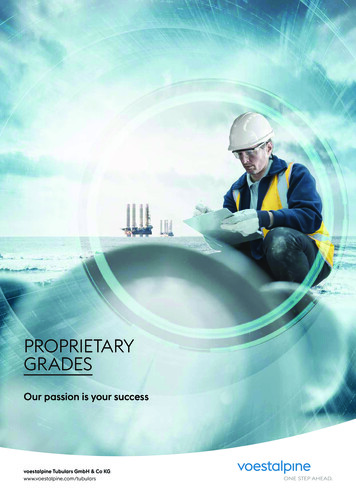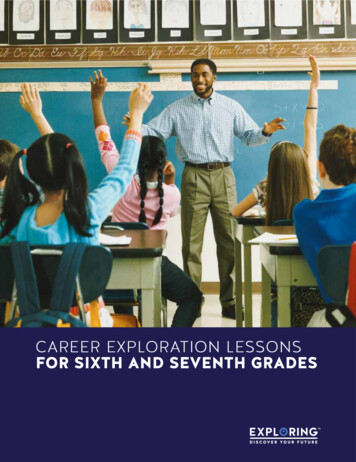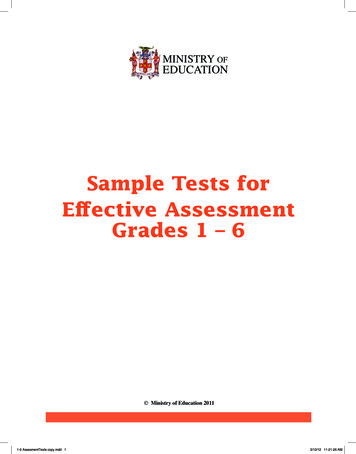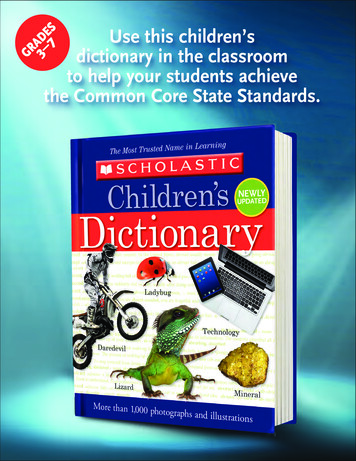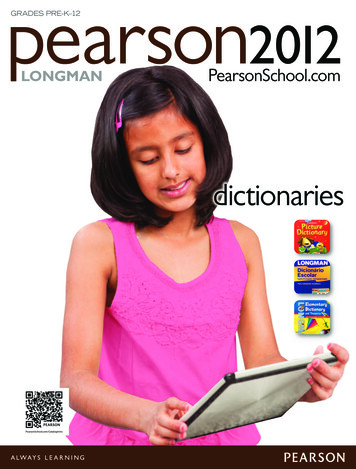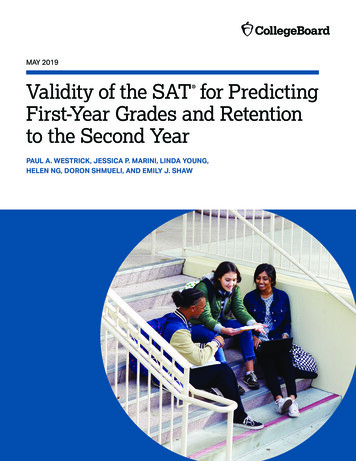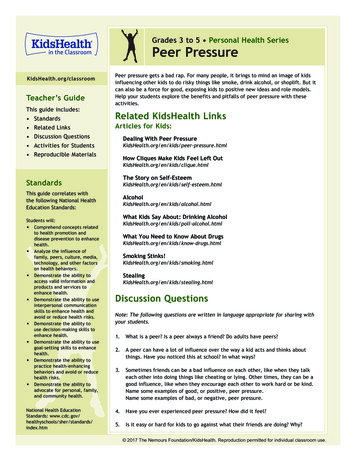
Transcription
Grades 3 to 5 Personal Health SeriesPeer PressureKidsHealth.org/classroomTeacher’s GuideThis guide includes: Standards Related LinksPeer pressure gets a bad rap. For many people, it brings to mind an image of kidsinfluencing other kids to do risky things like smoke, drink alcohol, or shoplift. But itcan also be a force for good, exposing kids to positive new ideas and role models.Help your students explore the benefits and pitfalls of peer pressure with theseactivities.Related KidsHealth LinksArticles for Kids: Discussion QuestionsDealing With Peer Pressure Activities for StudentsKidsHealth.org/en/kids/peer-pressure.html Reproducible MaterialsHow Cliques Make Kids Feel Left OutKidsHealth.org/en/kids/clique.htmlThe Story on teem.htmlThis guide correlates withthe following National HealthEducation Standards:Students will: Comprehend concepts relatedto health promotion anddisease prevention to enhancehealth. Analyze the influence offamily, peers, culture, media,technology, and other factorson health behaviors. Demonstrate the ability toaccess valid information andproducts and services toenhance health. Demonstrate the ability to useinterpersonal communicationskills to enhance health andavoid or reduce health risks. Demonstrate the ability touse decision-making skills toenhance health. Demonstrate the ability to usegoal-setting skills to enhancehealth. Demonstrate the ability topractice health-enhancingbehaviors and avoid or reducehealth risks. Demonstrate the ability toadvocate for personal, family,and community health.National Health EducationStandards: mAlcoholKidsHealth.org/en/kids/alcohol.htmlWhat Kids Say About: Drinking t You Need to Know About DrugsKidsHealth.org/en/kids/know-drugs.htmlSmoking KidsHealth.org/en/kids/stealing.htmlDiscussion QuestionsNote: The following questions are written in language appropriate for sharing withyour students.1.What is a peer? Is a peer always a friend? Do adults have peers?2.A peer can have a lot of influence over the way a kid acts and thinks aboutthings. Have you noticed this at school? In what ways?3.Sometimes friends can be a bad influence on each other, like when they talkeach other into doing things like cheating or lying. Other times, they can be agood influence, like when they encourage each other to work hard or be kind.Name some examples of good, or positive, peer pressure.Name some examples of bad, or negative, peer pressure.4.Have you ever experienced peer pressure? How did it feel?5.Is it easy or hard for kids to go against what their friends are doing? Why? 2017 The Nemours Foundation/KidsHealth. Reproduction permitted for individual classroom use.
Grades 3 to 5 Personal Health SeriesPeer PressureActivities for StudentsNote: The following activities are written in language appropriate for sharing with your students.Silent SignalsObjectives:Students will: Participate in a classroom experiment about peer pressure Discuss the nonverbal communication of peer pressureMaterials: Markers and white paperClass Time: 15 minutesActivity:[Note to instructor: To begin, send two helpers out of the room on a quick errand. Note: Be sure to choose lesssensitive students who won’t mind being singled out later.]While they are out, tell the rest of the students that they’re going to participate in an experiment about peerpressure. Have the students clear their desks, then hand out the markers and paper. Leave markers and paper onthe helpers’ desks as well. Ask each student to write the word “APPLE” in large letters and display the paper ontheir desk. Tell the class they are not to talk to the returning students, even if they ask what’s going on. No gigglingeither!Now wait for the helpers. What will they do when they return? Will they ask for an explanation? Will they ignore thesigns because they make no sense? Or will they pick up their markers and write the word “APPLE” because everyoneelse has?Afterward, ask the helpers why they did what they did. What made them follow along – or not? How was this anexample of peer influence?Extensions:1.Peer pressure can occur even when people don’t say a word. As a class, brainstorm ways that peer pressure canbe communicated through actions; for example, everybody doing, or wearing, or liking the same thing. How canbody language also make someone feel like they are or aren’t part of a group (hugging, huddling, sitting togetherat lunch, eye-rolling, staring, giggling, pointing)?2.Brainstorm ways students can help make the classroom a place of positive influences. 2017 The Nemours Foundation/KidsHealth. Reproduction permitted for individual classroom use.
Grades 3 to 5 Personal Health SeriesPeer PressureThink FirstObjectives:Students will: Respond to various peer pressure scenarios Explore possible positive and negative outcomes Enhance their decision-making skillsMaterials: Computer with Internet access“Think First” handout, pen or pencilClass Time: 40 minutesActivity:Whether it’s preschoolers playing in a sandbox or grannies having tea, one thing’s for sure: Friends influence friends.The trick is to know when that influence is leading you down the wrong path instead of the right path – and then tohave the courage to do something about it.Today, we’re going to take a look at five examples of peer pressure. For each, we’re going to determine the problem(what is being asked of you), the possible consequences (both the good and the bad), and what action you think youshould take. Afterward, we’ll discuss your responses. Which of these decisions were the easiest to make? Which werethe hardest?Extension:Ask for volunteers to role-play a few of these scenarios in front of the class. Practice different ways of refusing to goalong when you know you’re being pressured to do something wrong.Reproducible MaterialsHandout: Think g/peer pressure handout1.pdfQuiz: Peer wing/peer pressure quiz.pdfAnswer Key: Peer wing/peer pressure quiz answers.pdfKidsHealth.org is devoted to providing the latest children’s health information. The site, which is widelyrecommended by educators, libraries, and school associations, has received the “Teachers’ Choice Awardfor the Family” and the prestigious Pirelli Award for “Best Educational Media for Students.” KidsHealth comesfrom the nonprofit Nemours Foundation. Check out www.KidsHealth.org to see the latest additions! 2017 The Nemours Foundation/KidsHealth. Reproduction permitted for individual classroom use.
Personal Health SeriesPeer PressureName:Date:Think FirstInstructions: Here are five peer pressure situations. For each situation, use the chart below to thinkabout whether it would be a good idea to follow along or not.Problem:Consequences:Action:What does my friend want me to do? Is it something goodor bad? Kind or mean? Healthy or unhealthy? Legal or illegal? Is itsomething you would do if your parents were watching?What could happen if I do it? Imagine any possible good results: Will you learn somethingpositive? Will you be helping someone? Imagine any possible bad results: Can you get hurt? Can youget in trouble? Can someone else get hurt or in trouble?Should I do it? Will you be proud of your choice afterward? Would your parents be proud ofyour choice?1. You’re studying for tomorrow’s quiz when some of your teammates come by. They want you to shoot some hoops with them.“You’re not going to nerd out on us, are you?” they ask.Problem:Consequences:Action: 2017 The Nemours Foundation/KidsHealth. Reproduction permitted for individual classroom use.
Personal Health SeriesPeer PressureName:Date:2. You’re at the store, wishing you had enough money for some candy. Your friend says, “Just take it! It’s no big deal. The clerk’s noteven looking.”Problem:Consequences:Action:3. Your friends are trying to get you to try out for the school musical, but you’re not sure you have the guts. “Come on, do it! Youhave a great voice,” they say. “We’ll be there to cheer you on.”Problem:Consequences:Action: 2017 The Nemours Foundation/KidsHealth. Reproduction permitted for individual classroom use.
Personal Health SeriesPeer PressureName:Date:4. Your friend asks to “borrow” your homework – again – because he didn’t do it last night. He says if you don’t give it to him, youwon’t be invited to his party this weekend.Problem:Consequences:Action:5. You’re playing video games with your friends when one of them mentions a 5K race that’s coming up. You’ve never run a racebefore and aren’t sure you should start now, but your friend says, “I bet we can do it. Look, I printed out this training plan. Let’sstart tomorrow.”Problem:Consequences:Action: 2017 The Nemours Foundation/KidsHealth. Reproduction permitted for individual classroom use.
Personal Health SeriesPeer PressureName:Date:Quiz1. Peers are:a) people about your own ageb) classmatesc) teammatesd) all of the above2. In “peer pressure,” the word pressure means:a) hurtb) pushc) influenced) ignore3. True or false: Peer pressure is always bad.4. Fill in the blanks: When friends try to influence you to do things that are harmful or wrong, it’s calledpressure. When friends try to influence you to do things that are helpful or kind, it’s calledpeerpeer pressure.5. True or false: Only kids and teens have to deal with peer pressure.6. List two things kids might do to try to get other kids to do what they want:.7. List two reasons why kids might give in to peer pressure:.8. List two ways friends can be a bad influence on each other:.9. List two ways friends can be a good influence on each other:.10. True or false: People can influence each other without even speaking. 2017 The Nemours Foundation/KidsHealth. Reproduction permitted for individual classroom use.
Personal Health SeriesPeer PressureQuiz Answer Key1. Peers are:a) people about your own ageb) classmatesc) teammatesd) all of the above2. In “peer pressure,” the word pressure means:a) hurtb) pushc) influenced) ignore3. True or false: Peer pressure is always bad.4. Fill in the blanks: When friends try to influence you to do things that are harmful or wrong, it’s calledpressure. When friends try to influence you to do things that are helpful or kind, it’s calledpositivenegativepeerpeer pressure.5. True or false: Only kids and teens have to deal with peer pressure.6. List two things kids might do to try to get other kids to do what they want: Any two of the following: tease, call names,threaten, say they’re not cool, exclude from group, ignore, etc.7. List two reasons why kids might give in to peer pressure: Any two of the following: to seem cool, to seem brave, to get in with agroup of friends, to impress others, etc.8. List two ways friends can be a bad influence on each other: Any two of the following: they can encourage each other to smoke,drink, cheat, lie, steal, bully others, act lazy, act disrespectful, not do their homework, etc.9. List two ways friends can be a good influence on each other: Any two of the following: they can encourage each other to workhard in school or sports, try a positive new activity, believe in themselves, exercise, read a new book, be kind, be honest, etc.10. True or false: People can influence each other without even speaking. 2017 The Nemours Foundation/KidsHealth. Reproduction permitted for individual classroom use.
pressure. When friends try to influence you to do things that are helpful or kind, it’s called peer pressure. 5. True or false: Only kids and teens have to deal with peer pressure. 6. List two things kids might do to try to get other kids to do what they want:. 7. List two reasons why kids might give in to peer pressure:.


